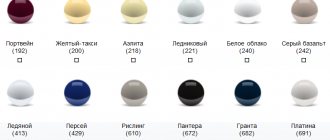The importance of the Toyota RAV4 model is difficult to overestimate: its name is synonymous with the word “success” in the automotive market. In fact, having founded the “class named after itself” back in 1994, the Toyota RAV4 crossover has been one of the all-time leaders and bestsellers in this segment for a quarter of a century - about 9 million copies have been sold. But can the new product repeat the successes of its predecessors? How will the new, already fifth, generation of Toyota RAV4 attract buyers against the backdrop of an increasing number of different competitors? I’ll try to answer in the format of a “first glance” from a pan-European test drive.
New generation RAV4 - what's new in it?
Platform, dimensions, design, construction. The fifth generation of Toyota RAV4 is built on the proprietary global TNGA architecture: in this case, the “middle” TNGA GA-K platform, which was previously found in the Toyota Camry sedan, is used. In general, the TNGA architecture is aimed at an overall comprehensive improvement of the car - a low center of gravity, lighter structure, more rigid body (+57% compared to the previous generation). Plus optimal use of every millimeter of space. Thus, the new Toyota RAV4 crossover has become even slightly shorter than its predecessor: length – 4,600 mm (-5 mm). Although the width, on the contrary, has increased – now 1,855 mm (+10 mm). The height is 1,685 mm. However, the wheelbase has grown the most – now 2,690 mm (+30 mm): this was achieved thanks to the reduction of the front and rear overhangs. The ground clearance is 190-195 mm depending on the car version and engine type.
Brief description for the new generation Toyota RAV4: the car has become more muscular and collected. I just want to write “the car has become more masculine”: sharp lines, highlighted wheel arches, narrow headlights, a dashing slope of the rear pillar. The reduced length promises ease of maneuvering in tight cities. On the contrary: the wheelbase has been increased - which has a positive effect on the spaciousness of the interior. The trunk has also grown: now 580 liters for the hybrid version, which is 79 liters more than the hybrid predecessor. A first for the Toyota RAV4, the car is available in two-tone with a black roof.
The Japanese attention to detail is impressive. Thus, according to company representatives, very careful work was carried out on weight distribution: not only between the front and rear axles (51/49%), but also between the left and right wheels - to achieve an even load, the location of the fuel tank even had to be slightly changed . The electric power steering motor was moved from the steering column to the rack - in order to improve the clarity of control and “natural” effort on the steering wheel. The aforementioned trunk, in addition to increasing its volume, is also better organized: pockets for small items, a double-sided floor (fleece covering and plastic covering for dirty items), hooks for bags. Another example: the low location of the engine made it possible to lower the hood line by 15 mm - and this, in turn, provided an increase in the viewing angle for the driver. A similar task was facilitated by thin A-pillars, as well as the arrangement of the interior with a “lower” front panel. Thanks to such techniques, the interior is literally filled with sunlight, which psychologically affects the perception of space.
And in general, the interior has changed a lot. The front panel now really seems lower: you see in front of you a plateau of soft plastic, where the “towers” of the central display and instrument panel rise. At times, the trim and shapes seem crude - a simple center part of the steering wheel (although there is nice leather on the rim), massive door handles, huge climate washers supported by silver trim from the early 2000s. And when the front passenger waddles in, his left knee will rest against the center console. But if you remember the appearance of the car, then I admit that it 100% fits into one image. And if you start studying the details, it turns out that the new product is not so simple: here are the instruments with a large central color display instead of the usual analog speedometer, here are the seats with developed “ears” of lateral support and 3-stage ventilation. Much attention is paid to the rear passengers - after all, it is a family car: it has become more spacious, there are ventilation deflectors, adjustable backrest angle, and heating.
Completely new interior architecture: the front panel is lower, the central display is now free-standing, and the climate control unit clearly stands out. Some roughness of the interior resonates well with the overall “assertive” design of the car. If we look at the details, the car is not so simple: the front seats have developed lateral support, the rear seats are wider and have more legroom, a neat unit for switching driving modes (Normal, Eco, Sport, plus a new Trail mode), a dedicated EV Mode button for switching the hybrid to electric vehicle mode.
Exterior and differences from the previous model
Compared to the previous fourth generation Toyota RAV4, the new car has sharper, “off-road” body lines and strict contours. The crossover gained some brutality, became 10 mm wider and just as shorter than its predecessor.
The wheelbase of this model has also increased by 30 millimeters, and somewhat unusual arches with right angles and plastic linings have noticeably risen above the wheels.
Other distinctive features of the car's appearance:
- a rather large trapezoidal radiator grille;
- angular LED headlights;
- placing side mirrors directly on the doors to improve visibility;
- taillights in the style of top Lexus models;
- correct rectangular tailgate;
- impressive front bumper with high-mounted foglights.
An iconic feature of the new Toyota RAV 4 is the rear view mirror, which in reality is no longer a mirror, but a monitor transmitting images in color from cameras with a resolution of almost 4K.
And if for some reason the image is not transmitted to the screen, then using the switch you can return to a regular mirror.
The rear bumper of the car, reinforced with plastic protection, looks no less solid, and the roof of the crossover is complemented by a “shark fin”.
The Toyota RAV4 5 model is now assembled on the TNGA K platform, exactly the same as the VIII generation Camry.
According to the manufacturer, in contrast to the previous version, the body rigidity of the new RAV4 has increased by 57 percent, ground clearance has increased by 13 mm, and is now 210 millimeters.
The maximum wheel diameter has grown to 19 inches, the car is now slightly lower, but the wheel track size has increased.
Was there only a hybrid on the test drive?
No, not only, but there were an overwhelming majority of hybrid versions. If the name RAV4 is synonymous with the word "success", but the word "hybrid" is synonymous with the Toyota brand. To understand the importance of hybrid technology: for the outgoing generation, the hybrid version of the RAV4 accounted for 85% (!) of total sales of this model in the pan-European market. And in Ukraine, the hybrid took off: it accounted for approximately half of the total sales of the model. In fact, the Toyota RAV4 hybrid replaces the diesel engines that were so popular in Europe a couple of years ago. From experience communicating with other Toyota hybrids - for example, the C-HR - we can say that the hybrid really allows you to drive with diesel consumption, plus it offers increased power and dynamics, as well as the ability to drive through a traffic jam only on electric power (yup, that same EV button Mode).
With the release of the new generation Toyota RAV4, the manufacturer expects that the share of hybrids will reach even 90% of total model sales for the pan-European market. The basis for such statements is a significant improvement in hybrid technology, where every detail has changed. The general design is known from the previous generation Toyota RAV4 Hybrid: a gasoline engine and an electric motor to drive the front wheels; the all-wheel drive version uses another electric motor to drive the rear wheels; a small NiMH traction battery is located near the second row seats. But in this design, every key node has been changed!
Thus, the 2.5-liter 4-cylinder gasoline engine A25A-FXS of the Dynamic Force family is now completely new: D-4S combined fuel injection, compression ratio 14:1, variable valve timing on the intake and exhaust. Traditionally for hybrids, the engine operates on the Atkinson (Miller) cycle. Together with the gasoline engine, a 3NM electric motor with a power of 88 kW (120 hp) also works - the total output of the hybrid power plant reaches 218 hp. or 160 kW. The all-wheel drive version also receives an electric motor to drive the rear wheels: 4NM series and a maximum power of 40 kW (54 hp), the maximum torque at the rear wheels can reach 1,300 Nm, which is 30% more than its predecessor ( 953 Nm). The total power of the Toyota RAV4 Hybrid with AWD-i all-wheel drive is slightly higher – 222 hp. or 163 kW. Depending on the different operating modes of different engines, the all-wheel drive hybrid receives a torque distribution between the front/rear axles in a proportion from “100:0” to “20:80”. The electronic components of the hybrid have also changed - the PCU (Power Control Unit) and the traction battery have decreased in size and become lighter (-11% for the battery). By the way, the NiMH (nickel metal hydride) battery operates with a nominal voltage of 245 volts (the maximum in a hybrid system can reach 650 volts), its capacity is 6.5 Ah.
The new generation of Toyota RAV4 Hybrid opens up a new level of power: 218-222 hp. depending on the type of drive (versus 197 hp for its predecessor). Maximum speed - 180 km/h (the same for versions with front-wheel drive or all-wheel drive), acceleration from 0-100 km/h is promised in 8.1-8.4 seconds, combined fuel consumption - 4.4-4.6 liters per 100 km of track (the last two parameters depend on the type of drive). The hybrid technology has been completely updated: a new gasoline engine, more traction for the rear wheels, a smaller and lighter traction battery. There is no usual gearbox: it uses a proprietary hybrid unit based on a planetary gear with a gear ratio of 3.605 - for the end buyer this system is perceived as an “automatic”.
However, the hybrid described above is not the only power unit for the new generation Toyota RAV4. After all, for some markets in Europe the regular naturally aspirated 2.0-litre 4-cylinder M20A-FKS petrol engine will also be offered. Although the word “ordinary” is not entirely fair: combined fuel injection D-4S, high compression ratio 13:1, dual (intake/exhaust) variable valve timing system. This engine develops 173-175 hp. (depending on the measurement method) and 208 Nm, the declared mixed fuel consumption is 5.6-6.4 liters per 100 km, depending on the type of drive and gearbox.
Moreover, the last clarification is not accidental, since the 2-liter versions are attracted by the variety of transmissions: 6-speed. “mechanics” or “automatic” (CVT-variator), front-wheel drive or all-wheel drive. Once again, Toyota has prepared many interesting, unusual solutions for the RAV4. So, as an “automatic”, a Direct Shift CVT variator is used, which has a real mechanical first gear - it is useful for off-road driving and slipping in the mud without risk to the “guts” of the variator. And the Dynamic Toque Vectoring all-wheel drive is interesting: it is a system of active torque redistribution using two friction clutches - separately for each rear wheel.
Main technical specifications of Toyota RAV4 2021
The fifth-generation compact crossover has a length of about 4.6 m, width and height of 1.85 and 1.7 m, respectively. The wheelbase of the car is 2.69 m, the turning circle is 11 meters.
The RAV4 comes standard with 225/65 tires on 17" wheels, and the wheels with a standard two-liter engine and basic options are front-wheel drive.
Crossovers with hybrid engines are available only with all-wheel drive, and it is possible to disable the rear axle, thereby switching the car to an economical 2WD mode.
The new 5th generation Toyota RAV4 in all versions is equipped with an electric steering wheel, all-disc brakes, independent front and rear suspensions, a McPherson strut is installed on the front axle, and a multi-link system at the rear.
The car is equipped with all kinds of safety equipment, including:
- traditional ABS system;
- electronic brake force distributor;
- assistance to the driver when starting on an incline;
- rear door locks;
- lane departure warning;
- monitoring of “blind spots”;
- adaptive cruise control;
- airbags – side, driver and front passenger;
- automatic braking system to avoid collisions;
- roof side curtain airbags;
- mounting points for installing a child seat.
The crossover has a fuel tank with a capacity of 55 liters, a curb weight of 1528 to 1645 kg, which varies depending on the type of engine and transmission.
The driver can optionally configure one of the three proposed driving options: select normal, economical or sport mode.
So, how's it going? Power, dynamics, comfort, handling...
During the test drive, you were able to drive only hybrid versions of the Toyota RAV4. But in different versions and conditions: front-wheel drive or all-wheel drive, highways, serpentines, light off-road. And overall – quite worthy! Although, I admit, without any special revelations in the matter of handling or dynamics: according to first impressions, the new 220-horsepower crossover is not far from the dynamics level of the previous Toyota RAV4 Hybrid - but the latter was also quite “peppy” for its class and format. Comparing the dynamics of acceleration from 0-100 km/h completely dots all the i's: comparable 8.1-8.5 seconds. And the Sport mode does not turn a crossover into a sports car: the steering wheel becomes noticeably heavier, the engine operates more often in the high-speed zone (and you can hear it), and the instrument panel display turns red. But these are just hints and not a real change in the character of the car.
The driving mode switch changes not only the engine settings, steering, display color, but also its backlight - original! Hybrids always have an EV Mode button: forced switching of the system to electric power: enough for a small traffic jam or driving through yards. In all-wheel drive versions, there is also a special “Trail Mode”: selective braking of the wheels to simulate a cross-axle differential.
In fact, the whole point of the Toyota RAV4 Hybrid is that it is the most versatile car for real life: it reveals itself in a soft or medium driving pace, there is a huge emphasis on suspension comfort. In this case, the hybrid transient processes are barely noticeable: just press the accelerator - the car moves forward, there is enough traction at low and medium speeds, and there is little or no noise from the engine. And the steering wheel is good: with moderate sharpness (a little less than three turns from lock to lock), light at low and medium speeds. On rare potholes and bumps on Spanish roads, the crossover rounds out as much as possible and “dissolves” almost all the irregularities: partly in the suspension, partly in the thick tires. Also, the suspension is good on light off-road conditions. But something else surprised me more off-road: this is the first “civilian” all-wheel drive hybrid in my memory, which has enough power from the rear electric motor to spare!
Relatively low weight and increased torque (compared to the previous generation) have meant that there is now enough traction at the rear to push the car off-road or to “give the gas” when exiting a turn on a dirt road. If you add to this an energy-intensive suspension, then the off-road crossover goes really well: there is enough power, there is enough softness... But sometimes there is not enough suspension travel: the wheel can be hung even on a moderate slope. And the front bumper with its protruding lip seems too low - sometimes you had to be careful. Of course, all this applies only to the version with the AWD-i full hybrid drive; the path to the cross-country track for the front-wheel drive hybrid was closed. Off-road capabilities are the main difference between them. Otherwise, the dynamics and acceleration are very similar, only sometimes wheel slip is noticeable - with a sharp start on a dirt road or asphalt with sand and gravel. It’s a pity, but right now I won’t be able to say how the 2-liter version with traditional all-wheel drive behaves: we’ll leave this conversation, as well as the dynamics measurements, for Ukraine.
In one phrase: everything you expect from a crossover like the Toyota RAV4 on light off-road conditions, it does without problems and with pleasure. And more is already the territory of pickup trucks and SUVs. The ground clearance of the hybrid is 190 mm, the approach/departure angles are 17.5/20 degrees. But these data are for the European version of the car, and the crossover may arrive in Ukraine with a slightly modified suspension and/or on tires of a different size - as a result, the ground clearance and approach/departure angles will change.
Fuel consumption
Compared to its competitors, the Toyota RAV4 5 consumes relatively little fuel, but not all Japanese crossovers are economical, and much depends on driving style.
The most voracious are all-wheel drive “non-hybrid” cars in “sports” and top-end configurations with an average gasoline consumption of 8.7 liters per 100 km, and on the highway and in the city – 7.4 and 9.8 liters per “hundred”, respectively.
Cars with hybrid powertrains are very economical, although with a 4x4 drive, they consume an average of 6.0 liters of gasoline, and in urban areas and on the highway - 6.4 and 5.7 l/100 km.
Front-wheel drive cars consume fuel "average/city/highway" - 8.1/ 7.1/ 9.0 liters/100 km, and all these results are much better when comparing the new model with the previous generation RAV.
OK, generally clear. What about the details: equipment, functions, systems?
The new generation of the Toyota RAV4 crossover also received a new generation of proprietary TSS (Toyota Safety Sense) technology - this is the second in a row. In general, TSS is a set of various systems and functions to assist the driver while driving: lane control, adaptive cruise, emergency braking. Now the TTS complex has been redesigned, the number of available functions has been expanded: for example, the emergency braking system has learned to recognize cyclists, pedestrian recognition has been added at night, active lane control can “correct” the car within its lane. Adaptive cruise control is now “intelligent” (iACC, intelligent Adaptive Cruise Control): it works in tandem with the traffic sign recognition function and provides tips and recommendations on the permissible speed. Such improvements and expansions of functionality became possible thanks to the car’s new “sense organs”: a radar in the radiator grille and vision cameras. The new product also received a JBL audio system (9 speakers) and a “smart” rear-view mirror: in fact, an LCD display on which the image from the rear-view camera is displayed.
The new Toyota RAV4 crossover also received a new TTS (Toyota Safety Sense) complex - this is the second generation: cyclist recognition has appeared, pedestrian recognition has been improved, adaptive cruise control has become “smart”. The rear-view mirror can now hide an LCD display for an overview of the situation behind the car: no more problems with a trunk loaded to the roof. The new product can also offer wireless charging for a smartphone, several USB ports, and all-round visibility.
Reasons for popularity
Immediately after its appearance on the market, the RAV4 brand gained enormous popularity due to its excellent off-road qualities, compact size, impeccable assembly, and excellent technical characteristics.
During its existence, four generations of this model have changed, and in the early spring of 2018, representatives of the Japanese concern announced the 5th generation Toyota RAV4 crossover at the New York exhibition.
The car has been on sale in America since December 2021. The start of sales in Russia, according to preliminary information, should take place no earlier than December 2021, the base price of the standard configuration will be 1 million 590 thousand rubles.
When to wait in Ukraine? And how much?
Wait already in February. Official Toyota dealers have opened orders for the new generation RAV4 crossover since January 14; the first “customer” cars are promised to be delivered in February. I am glad that Ukraine belongs to those “certain markets” - and we will have two engines available: a 2-liter with different transmissions and a 2.5-liter hybrid with 218 “horses” with front-wheel drive. Hybrid 222 hp and with all-wheel drive will arrive a little later: approximately at the end of spring. It is also known that in Ukraine, for each of the engines, five trim levels will be offered for the client to choose from - a total of a dozen versions of the Toyota RAV4. What's good: everyone can choose the RAV4 according to their preferences and budget. But I can’t say the exact prices yet: at the time of preparing the material, the price list was in final approval mode. Although it all depends on the date when you read these lines, it is possible that prices are already available on the Toyota Ukraine website.
But I can already say that everything is heading towards another “bestseller” title in the history of the Toyota RAV4: comfortable and spacious, with a new style and bright design, plus a lot of advanced equipment – and without global failures. And if so, then the potential bestseller clearly deserves a more detailed study: if possible, I will once again return to the topic of the Toyota RAV4 in full-format review mode, taking into account the nuances of driving on Ukrainian roads, plus compare with competitors, analyze the situation with the 2-liter version, and record the consumption fuel and calculate the maintenance. Don't switch!
Options
The fifth generation Toyota RAV4, even in the standard version, has very good equipment; the standard set of car options includes:
- light alloy wheels of 17 diameter;
- multimedia system;
- Rear View Camera;
- Rain sensor;
- rear parking sensors;
- seven airbags;
- electrically controlled side mirrors;
- heated front seats;
- air conditioning system;
- four power windows;
- a control device that monitors tire pressure;
- hands-free function;
- assistance to the driver when starting on a hill;
- ESP and ABS systems;
- audio system with speakers.
In the top version, the optional set is expanded by the presence of:
- panoramic roof;
- 360 degree camera;
- there is adaptive cruise control;
- navigation system; leather interior;
- alloy wheels R18;
- electric front seats;
- various driver assistants that provide more comfortable and safe driving.
Which specific configurations will be available to Russian consumers will become clear immediately after the start of sales of the crossover in Russia, since the optional equipment of the car may differ from the European or American version.











